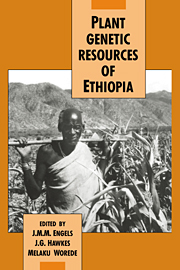Book contents
- Frontmatter
- Contents
- Contributors
- List of acronyms
- Preface
- Part I General introduction
- Part II The Ethiopian centre of diversity
- Part III Germplasm collection and conservation in Ethiopia
- Part IV Evaluation and utilization of Ethiopian genetic resources
- 18 Germplasm evaluation with special reference to the role of taxonomy in genebanks
- 19 Crop germplasm multiplication, characterization, evaluation and utilization at PGRC/E
- 20 Evaluation methods and utilization of germplasm of annual crop species
- 21 Evaluation and utilization of Ethiopian forage species
- 22 Improvement of indigenous durum wheat landraces in Ethiopia
- 23 Use of germplasm resources in breeding wheat for disease resistance
- 24 Indigenous barley germplasm in the Ethiopian breeding programme
- 25 The role of Ethiopian sorghum germplasm resources in the national breeding programme
- 26 Germplasm evaluation and breeding work on teff (Eragrostis tef) in Ethiopia
- 27 Pulse crops of Ethiopia: genetic resources and their utilization
- 28 Oil crop germplasm: a vital resource for the plant breeder
- 29 Significance of Ethiopian coffee genetic resources to coffee improvement
- 30 Use of Ethiopian germplasm in national and international programmes
- Index
27 - Pulse crops of Ethiopia: genetic resources and their utilization
Published online by Cambridge University Press: 30 October 2009
- Frontmatter
- Contents
- Contributors
- List of acronyms
- Preface
- Part I General introduction
- Part II The Ethiopian centre of diversity
- Part III Germplasm collection and conservation in Ethiopia
- Part IV Evaluation and utilization of Ethiopian genetic resources
- 18 Germplasm evaluation with special reference to the role of taxonomy in genebanks
- 19 Crop germplasm multiplication, characterization, evaluation and utilization at PGRC/E
- 20 Evaluation methods and utilization of germplasm of annual crop species
- 21 Evaluation and utilization of Ethiopian forage species
- 22 Improvement of indigenous durum wheat landraces in Ethiopia
- 23 Use of germplasm resources in breeding wheat for disease resistance
- 24 Indigenous barley germplasm in the Ethiopian breeding programme
- 25 The role of Ethiopian sorghum germplasm resources in the national breeding programme
- 26 Germplasm evaluation and breeding work on teff (Eragrostis tef) in Ethiopia
- 27 Pulse crops of Ethiopia: genetic resources and their utilization
- 28 Oil crop germplasm: a vital resource for the plant breeder
- 29 Significance of Ethiopian coffee genetic resources to coffee improvement
- 30 Use of Ethiopian germplasm in national and international programmes
- Index
Summary
Introduction
Ethiopia is known as a centre of diversity and/or origin of numerous cultivated crop plant species. This was first recognized by N. I. Vavilov in the late 1920s and later confirmed by several other scientists. Vavilov (1951) indicated that some 38 crop plants have their centre of diversity in the Ethiopian region. Zohary (1970) mentioned 11 crop species which had their centre of diversity in Ethiopia. Primitive cultivars or landraces and wild relatives of some of the world's major crops are found in the country. Pulse crops form a significant portion of the available genetic resource base for plant breeding programmes.
In this chapter an attempt is made to describe the situation for the most important pulse crops cultivated in Ethiopia regarding their diversity and the germplasm kept in the national collection, and their conservation, evaluation and utilization.
Collection
Owing to the richness and potential of the biological resources of the country, numerous plant expeditions have been undertaken by scientists in the past. However, it was only after the establishment of the Plant Genetic Resources Centre/Ethiopia (PGRC/E) in 1976 that systematic collecting missions were launched. The total holding of pulse accessions by PGRC/E is about 4300.
The bulk of the germplasm was acquired from field collecting (ca. 2900) on the basis of a well defined strategy, and some was acquired through repatriation and acquisition from national and international sources.
- Type
- Chapter
- Information
- Plant Genetic Resources of Ethiopia , pp. 329 - 343Publisher: Cambridge University PressPrint publication year: 1991
- 2
- Cited by



